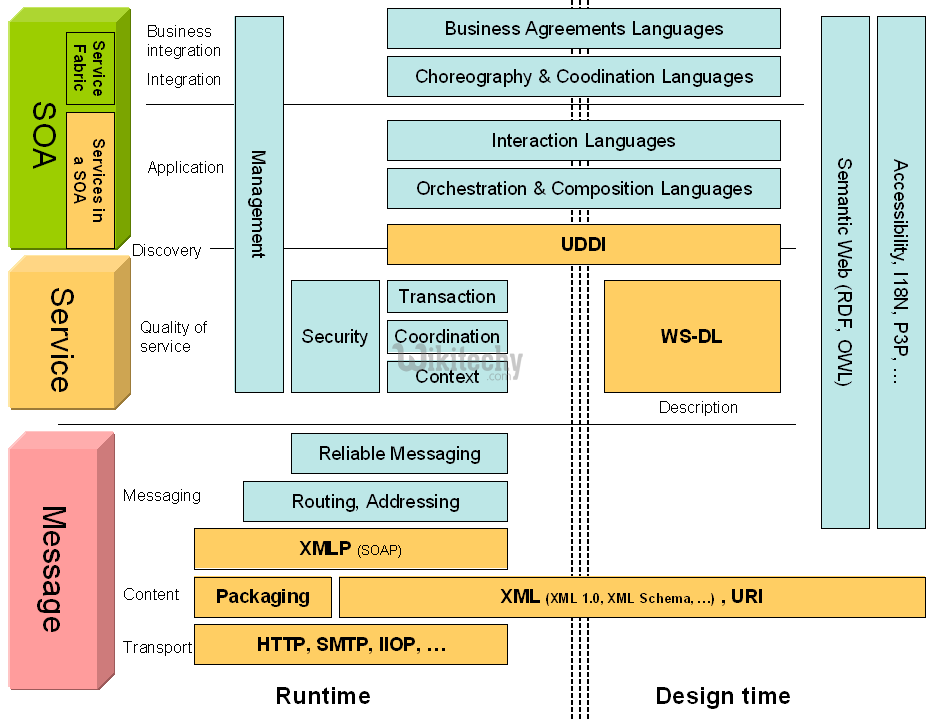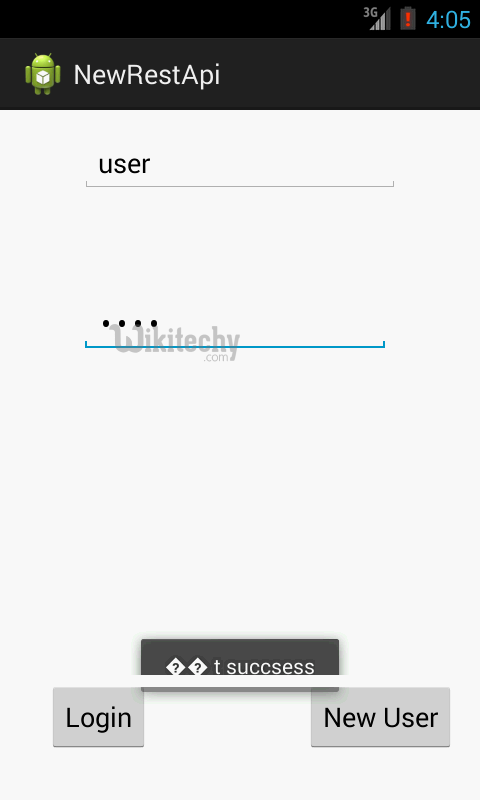Android tutorial - web service android - android app development - android studio - android development tutorial

What Are Web Services?
- Web services are client & server applications that communicate over the (WWW) - World Wide Web’s (HTTP) - HyperText Transfer Protocol.
- As described by the (W3C) - World Wide Web Consortium, web services offer a standard means of interoperating between software applications running on a variety of platforms & frameworks.
- Web services are characterized by their great interoperability & extensibility, as well as their machine-processable descriptions, thanks to the use of XML.
- Web services can be joint in a lightly attached way to achieve complex operations.
- Programs providing simple services can interact with each other to deliver sophisticated added-value services.

Android Web Service
- Creating a web service application in android is not a tough task.
- We can easily create a restful web service application in android to authenticate or save information into the external database such as oracle, mysql, postgre sql, sql server using other application developed in java, .net, php etc languages.
Android Restful Web Service Tutorial
- Previously developing web services application, you must have the basic knowledge of SOAP & Restful web services.
- why, we are going to discuss basic points about web services such as what is web service & brief information about SOAP & also Restful web services.
What is Web Service?
- A web service is a standard for exchanging information between different types of applications irrespective of language & platform.
- For ex, Using web services, android application can interact with java or .net application.

Android Restful Web Service Example
- File: activity_main.xml
<RelativeLayout xmlns:android="http://schemas.android.com/apk/res/android"
xmlns:tools="http://schemas.android.com/tools"
android:layout_width="match_parent"
android:layout_height="match_parent"
android:paddingBottom="@dimen/activity_vertical_margin"
android:paddingLeft="@dimen/activity_horizontal_margin"
android:paddingRight="@dimen/activity_horizontal_margin"
android:paddingTop="@dimen/activity_vertical_margin"
tools:context=".MainActivity" >
<EditText
android:id="@+id/editText1"
android:layout_width="wrap_content"
android:layout_height="wrap_content"
android:layout_alignParentTop="true"
android:layout_centerHorizontal="true"
android:hint="Username"
android:ems="10" >
<requestFocus />
</EditText>
<EditText
android:id="@+id/editText2"
android:layout_width="wrap_content"
android:layout_height="wrap_content"
android:layout_alignLeft="@+id/editText1"
android:layout_below="@+id/editText1"
android:layout_marginTop="67dp"
android:ems="10"
android:hint="Password"
android:inputType="textPassword" />
<Button
android:id="@+id/button2"
android:layout_width="wrap_content"
android:layout_height="wrap_content"
android:layout_alignParentBottom="true"
android:layout_marginBottom="24dp"
android:layout_toRightOf="@+id/button1"
android:text="New User" />
<ProgressBar
android:id="@+id/progressBar1"
style="?android:attr/progressBarStyleLarge"
android:layout_width="wrap_content"
android:layout_height="wrap_content"
android:layout_alignLeft="@+id/button1"
android:layout_below="@+id/editText2"
android:layout_marginTop="22dp" />
<Button
android:id="@+id/button1"
android:layout_width="wrap_content"
android:layout_height="wrap_content"
android:layout_alignLeft="@+id/editText2"
android:layout_below="@+id/progressBar1"
android:layout_marginLeft="22dp"
android:text="Login" />
</RelativeLayout>
click below button to copy the code from android tutorial team
- File: activity_register_user.xml
<RelativeLayout xmlns:android="http://schemas.android.com/apk/res/android"
android:layout_width="fill_parent"
android:layout_height="fill_parent" >
<EditText
android:id="@+id/editText1"
android:layout_width="wrap_content"
android:layout_height="wrap_content"
android:layout_alignParentTop="true"
android:layout_centerHorizontal="true"
android:layout_marginTop="15dp"
android:ems="10"
android:hint="Enter UserName" />
<EditText
android:id="@+id/editText2"
android:layout_width="wrap_content"
android:layout_height="wrap_content"
android:layout_alignLeft="@+id/editText1"
android:layout_below="@+id/editText1"
android:layout_marginTop="50dp"
android:ems="10"
android:hint="Enter Password"
android:inputType="textPassword" />
<Button
android:id="@+id/button1"
android:layout_width="wrap_content"
android:layout_height="wrap_content"
android:layout_alignParentBottom="true"
android:layout_centerHorizontal="true"
android:text="Resister" />
<ProgressBar
android:id="@+id/progressBar1"
style="?android:attr/progressBarStyleLarge"
android:layout_width="wrap_content"
android:layout_height="wrap_content"
android:layout_alignLeft="@+id/button1"
android:layout_below="@+id/editText2"
android:layout_marginTop="87dp" />
</RelativeLayout>
click below button to copy the code from android tutorial team
MainActivity class
- File: MainActivity.java
package com.example.newrestapi;
import java.io.BufferedReader;
import java.io.InputStream;
import java.io.InputStreamReader;
import java.util.ArrayList;
import java.util.List;
import org.apache.http.HttpEntity;
import org.apache.http.HttpResponse;
import org.apache.http.NameValuePair;
import org.apache.http.client.HttpClient;
import org.apache.http.client.entity.UrlEncodedFormEntity;
import org.apache.http.client.methods.HttpPost;
import org.apache.http.impl.client.DefaultHttpClient;
import org.apache.http.message.BasicNameValuePair;
import android.os.AsyncTask;
import android.os.Bundle;
import android.app.Activity;
import android.content.Intent;
import android.view.View;
import android.view.View.OnClickListener;
import android.widget.Button;
import android.widget.EditText;
import android.widget.ProgressBar;
import android.widget.Toast;
public class MainActivity extends Activity {
EditText password,userName;
Button login,resister;
ProgressBar progressBar;
protected void onCreate(Bundle savedInstanceState) {
super.onCreate(savedInstanceState);
setContentView(R.layout.activity_main);
password=(EditText) findViewById(R.id.editText2);
userName=(EditText) findViewById(R.id.editText1);
login=(Button) findViewById(R.id.button1);
resister=(Button) findViewById(R.id.button2);
//progess_msz.setVisibility(View.GONE);
progressBar=(ProgressBar) findViewById(R.id.progressBar1);
progressBar.setVisibility(View.GONE);
resister.setOnClickListener(new OnClickListener() {
@Override
public void onClick(View arg0) {
// TODO Auto-generated method stub
Intent intent=new Intent(MainActivity.this,ResisterUser.class);
startActivity(intent);
}
});
login.setOnClickListener(new OnClickListener() {
public void onClick(View v) {
progressBar.setVisibility(View.VISIBLE);
String s1=userName.getText().toString();
String s2=password.getText().toString();
new ExecuteTask().execute(s1,s2);
}
});
}
class ExecuteTask extends AsyncTask<String, Integer, String>
{
@Override
protected String doInBackground(String... params) {
String res=PostData(params);
return res;
}
@Override
protected void onPostExecute(String result) {
progressBar.setVisibility(View.GONE);
//progess_msz.setVisibility(View.GONE);
Toast.makeText(getApplicationContext(), result, 3000).show();
}
}
public String PostData(String[] valuse) {
String s="";
try
{
HttpClient httpClient=new DefaultHttpClient();
HttpPost httpPost=new HttpPost("http://10.0.0.8:7777/HttpPostServlet/servlet/Login");
List<NameValuePair> list=new ArrayList<NameValuePair>();
list.add(new BasicNameValuePair("name", valuse[0]));
list.add(new BasicNameValuePair("pass",valuse[1]));
httpPost.setEntity(new UrlEncodedFormEntity(list));
HttpResponse httpResponse= httpClient.execute(httpPost);
HttpEntity httpEntity=httpResponse.getEntity();
s= readResponse(httpResponse);
}
catch(Exception exception) {}
return s;
}
public String readResponse(HttpResponse res) {
InputStream is=null;
String return_text="";
try {
is=res.getEntity().getContent();
BufferedReader bufferedReader=new BufferedReader(new InputStreamReader(is));
String line="";
StringBuffer sb=new StringBuffer();
while ((line=bufferedReader.readLine())!=null)
{
sb.append(line);
}
return_text=sb.toString();
} catch (Exception e)
{
}
return return_text;
}
} click below button to copy the code from android tutorial team
RegisterUser class
- File: RegisterUser.java
package com.example.newrestapi;
import java.util.ArrayList;
import java.util.List;
import org.apache.http.NameValuePair;
import org.apache.http.client.HttpClient;
import org.apache.http.client.entity.UrlEncodedFormEntity;
import org.apache.http.client.methods.HttpPost;
import org.apache.http.impl.client.DefaultHttpClient;
import org.apache.http.message.BasicNameValuePair;
import android.os.AsyncTask;
import android.os.Bundle;
import android.app.Activity;
import android.view.View;
import android.view.View.OnClickListener;
import android.widget.Button;
import android.widget.EditText;
import android.widget.ProgressBar;
public class ResisterUser extends Activity {
EditText userName,passwprd;
Button resister,login;
ProgressBar progressBar;
protected void onCreate(Bundle savedInstanceState) {
super.onCreate(savedInstanceState);
setContentView(R.layout.activity_resister_user);
userName=(EditText) findViewById(R.id.editText1);;
passwprd=(EditText) findViewById(R.id.editText2);
resister=(Button) findViewById(R.id.button1);
progressBar=(ProgressBar) findViewById(R.id.progressBar1);
progressBar.setVisibility(View.GONE);
resister.setOnClickListener(new OnClickListener() {
@Override
public void onClick(View v) {
progressBar.setVisibility(View.VISIBLE);
String s1=userName.getText().toString();
String s2=passwprd.getText().toString();
new ExecuteTask().execute(s1,s2);
}
});
}
class ExecuteTask extends AsyncTask<String, Integer, String>
{
@Override
protected String doInBackground(String... params) {
PostData(params);
return null;
}
@Override
protected void onPostExecute(String result) {
progressBar.setVisibility(View.GONE);
}
}
public void PostData(String[] valuse) {
try
{
HttpClient httpClient=new DefaultHttpClient();
HttpPost httpPost=new HttpPost(
"http://10.0.0.8:7777/HttpPostServlet/servlet/httpPostServlet");
List<NameValuePair> list=new ArrayList<NameValuePair>();
list.add(new BasicNameValuePair("name", valuse[0]));
list.add(new BasicNameValuePair("pass",valuse[1]));
httpPost.setEntity(new UrlEncodedFormEntity(list));
httpClient.execute(httpPost);
}
catch(Exception e)
{
System.out.println(e);
}
}
}
click below button to copy the code from android tutorial team
File: AndroidManifest.xml
- You need to offer INTERNET approval in AndroidManifest.xml file.
<?xml version="1.0" encoding="utf-8"?>
<manifest xmlns:android="http://schemas.android.com/apk/res/android"
package="com.example.newrestapi"
android:versionCode="1"
android:versionName="1.0" >
<uses-sdk
android:minSdkVersion="8"
android:targetSdkVersion="17" />
<uses-permission android:name="android.permission.INTERNET" />
<application
android:allowBackup="true"
android:icon="@drawable/ic_launcher"
android:label="@string/app_name"
android:theme="@style/AppTheme" >
<activity
android:name="com.example.newrestapi.MainActivity"
android:label="@string/app_name" >
<intent-filter>
<action android:name="android.intent.action.MAIN" />
<category android:name="android.intent.category.LAUNCHER" />
</intent-filter>
</activity>
<activity
android:name="com.example.newrestapi.ResisterUser"
android:label="@string/title_activity_resister_user" >
</activity>
</application>
</manifest>
click below button to copy the code from android tutorial team
- download this android example
Output:


Java Servlet Login and Register example using oracle database
- Create table wikitechy_user in the oracle database having three columns id, name and password. Id must be primary key and generated through SEQUENCE.
CREATE TABLE "WIKITECHY_USER"
( "ID" NUMBER,
"NAME" VARCHAR2(4000),
"PASSWORD" VARCHAR2(4000),
CONSTRAINT "WIKITECHY_USER_PK" PRIMARY KEY ("ID") ENABLE
)
/
click below button to copy the code from android tutorial team
- New create two servlet classes to login and register user.
Login Servlet class
- File: Login.java
package server;
import java.io.IOException;
import java.io.ObjectOutputStream;
import java.sql.Connection;
import java.sql.DriverManager;
import java.sql.PreparedStatement;
import java.sql.ResultSet;
import javax.servlet.ServletException;
import javax.servlet.http.HttpServlet;
import javax.servlet.http.HttpServletRequest;
import javax.servlet.http.HttpServletResponse;
public class Login extends HttpServlet {
public void doGet(HttpServletRequest request, HttpServletResponse response)
throws ServletException, IOException {
response.setContentType("text/html");
ObjectOutputStream out=new ObjectOutputStream(response.getOutputStream());
String n=request.getParameter("name");
String p=request.getParameter("pass");
System.out.println(n);
System.out.println(p);
if(validate(n, p)){
out.writeObject("success");
}
else{
out.writeObject("Sorry username or password error");
}
out.close();
}
public static boolean validate(String name,String pass){
boolean status=false;
try{
Class.forName("oracle.jdbc.driver.OracleDriver");
Connection con=DriverManager.getConnection(
"jdbc:oracle:thin:@localhost:1521:xe","system","oracle");
PreparedStatement ps=con.prepareStatement(
"select * from wikitechy_user where name=? and password=?");
ps.setString(1,name);
ps.setString(2,pass);
ResultSet rs=ps.executeQuery();
status=rs.next();
}catch(Exception e){System.out.println(e);}
return status;
}
public void doPost(HttpServletRequest request,HttpServletResponse response)
throws ServletException, IOException {
doGet(request, response);
}
}
click below button to copy the code from android tutorial team
httpPostServlet Servlet class
- File: httpPostServlet.java
package server;
import java.io.IOException;
import java.sql.Connection;
import java.sql.DriverManager;
import java.sql.PreparedStatement;
import javax.servlet.ServletException;
import javax.servlet.http.HttpServlet;
import javax.servlet.http.HttpServletRequest;
import javax.servlet.http.HttpServletResponse;
public class httpPostServlet extends HttpServlet {
public void doGet(HttpServletRequest request,HttpServletResponse response)
throws ServletException, IOException {
response.setContentType("text/html");
String recived_data="";
String s1=request.getParameter("name");
String s2=request.getParameter("pass");
System.out.println(s1);
System.out.println(s2);
try
{
Class.forName("oracle.jdbc.driver.OracleDriver");
Connection con=DriverManager.getConnection(
"jdbc:oracle:thin:@localhost:1521:xe","system","oracle");
PreparedStatement ps=con.prepareStatement(
"insert into wikitechy_user(name,password) values(?,?)");
ps.setString(1, s1);
ps.setString(2,s2);
ps.executeUpdate();
con.close();
}
catch (Exception e) {
e.printStackTrace();
}
}
public void doPost(HttpServletRequest request,HttpServletResponse response)
throws ServletException, IOException {
doGet(request, response);
}
}
click below button to copy the code from android tutorial team
index.jsp
<form action="servlet/Login">
Name:<input type="text" name="name"/><br/>
Password:<input type="password" name="pass"/><br/>
<input type="submit" value="login"/>
</form>
